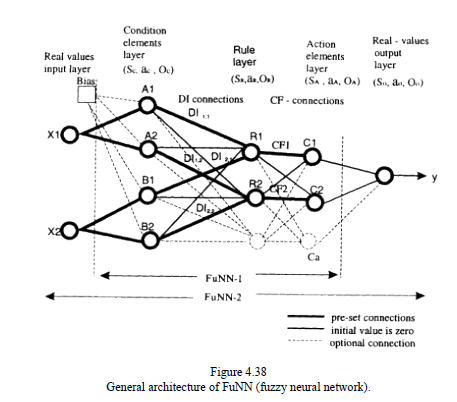Fuzzy Neural Networks
Introduction:-Similar to the way the fuzzy neuron and the neo-fuzzy neuron were created, different types of fuzzy neural networks have been developed and applied to different tasks. A fuzzy neural network (FNN) is a connectionist model for fuzzy rules implementation and inference. There is a great variety of architectures and functionalities of FNN. The FNNs developed so far differ mainly in the following parameters:
1. Type of fuzzy rules implemented; this affects the connectionist structure used.
2. Type of inference method implemented; this affects the selection of different neural network parameters and neuronal functions, such as summation, activation, and output function. It also influences the way the connection weights are initialized before training, and interpreted after training.
3. Mode of operation: we consider here three major modes of operation by:-
-
Fixed mode, ''fixed membership functions-fixed set of rules," that is, a fixed set of rules is inserted in a network, the network performs inference, but does not change its weights. It cannot learn and adapt. A representative of this type of system is NPS.
-
Learning mode, that is, a neural network is structurally defined to capture knowledge in a certain format, for example, some type of fuzzy rules. The network architecture is randomly initialized and trained with a set of data. Rules are then extracted from the structured network. The rules can be interpreted either in the same network structure or by using other inference methods.
- Adaptation mode. A neural network is structurally set according to a set of existing rules, "hints," heuristics. The network is then trained with new data and updated rules are extracted from its structure.
 FNNs have two major aspects:-
FNNs have two major aspects:-
1. Structural. A set of rules is used to define the initial structure of a neural network; two types of neural networks have been mainly used so far: (a) multilayer perceptrons (MLPs), and (b) radial-basis functions networks.
2. Functional, parametric. After having defined the structure of a neural network and possibly havingtrained it with data, some parameters can be observed that would explain the inference which the network performs. Those parameters can be used to derive a (fuzzy) rule-based system represented in linguistic terms.
FuNN is an model of an FNN. It facilitates learning from data, fuzzy rules extraction, and approximate reasoning. FuNN uses an MLP network and a backpropagation training algorithm. It is an adaptable FNN as the membership functions of the fuzzy predicates, as well as the fuzzy rules inserted before training (adaptation), may adapt and change according to the training data. The general architecture of FuNN consists of five following layers.In the input layer—a node represents an input variable. In the condition elements layer—each node represents a fuzzy predicate of an input variable. The activation values of the nodes represent the membership degrees of the input variables. Different summation function sc, activation function ac, and output function sc can be used for the neurons of this layer.